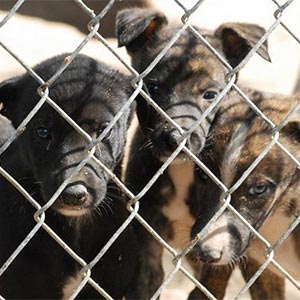Greyhound drug positives from around the world
Jump to:
Cocaine positives worldwide
Female greyhounds and anabolic steroids
US greyhound breeder convicted in industry drug conspiracy
Anabolic steroids are harmful
US trainers ignore steroid bans
Steroid use in greyhounds has been prohibited
Many greyhounds test positive for serious drugs, including cocaine. In the United States, female greyhounds are given anabolic steroids to prevent loss in race days.
Five racing countries have regulatory frameworks in place to handle drug screening — Australia, Ireland, New Zealand, the United Kingdom and the United States. Industry organizations, or industry-captured racing commissions, are responsible for self-policing and self-penalizing drug violations.
In the United States, state racing commissions are charged with regulating drug use in the racing industry. Rulings are public records. Since 2008, GREY2K USA Worldwide has documented over 600 violations in West Virginia and former racing states, including drug positive tests for cocaine, ractopamine, anabolic steroid metandienone, and industrial solvent dimethyl sulfoxide.
In Australia, each state and territory has its own industry body. Since 2008, hundreds of greyhound drug positives have been revealed. In Queensland, greyhounds have tested positive for amphetamine, morphine, and pentobarbitone, a barbiturate. In New South Wales, greyhounds have tested positive for EPO, amphetamine, and codeine. Between 2015 and April 2018, 201 greyhounds tested positive for drugs in New South Wales. In Victoria, eight greyhounds tested positive for codeine and morphine in 2016. In Tasmania, greyhounds have tested positive for caffeine and cobalt. In South Australia, greyhounds have tested positive for amphetamine and cobalt. Additionally, greyhounds in Australia test positive for unusual drugs. In Queensland, a greyhound tested positive for Desvenlafaxine, a drug normally used to treat depression and which isn’t used at all in veterinary medicine. In Western Australia, a greyhound tested positive for Fertagyl, a drug normally used in cows to control estrus cycles.

Greyhound Racing Ireland has posted 243 greyhound drug positives between 2012 and 2023 in the form of Control Committee Reports and Adverse Analytical Findings. These include cocaine, amphetamine, and pentobarbital positives. While cocaine and amphetamine are known as dangerous performance-enhancing drugs, pentobarbital is a performance-reducing drug. In large doses, it is lethal and appears in nearly 20% of all GRI drug positives.
In New Zealand, the Racing Integrity Unit found fifty-four greyhound drug positives from 2014 to 2023. According to New Zealand’s Judicial Control Authority, some of these positives were morphine. Additionally, two greyhound trainers tested positive for cannabis. Five of the positives in 2022 were for methamphetamine.
In the United Kingdom, the Greyhound Board of Great Britain has reported 318 greyhound drug positives between 2016-2022. The GBGB introduced a Point of Registration scheme in 2017, whereby a greyhound is screened prior to taking part in its first race. Between 2017-2022, and additiona 363 positive samples in greyhounds were detected at POR. These include stanozolol, barbiturates, and morphine. Stanozolol is a synthetic anabolic steroid and has been banned for its performance-enhancing influence. Barbiturates are central nervous system depressants and are serious performance-affecting drugs. Morphine has been used as a masking agent in greyhounds to make dogs less aware of any injuries they may have.

In Scotland, a December 2016 newspaper investigation found that race fixing with drugs occurred with regularity at non-registered “flapping” tracks. A trainer admitted to giving his dog valoids to slow him down, waiting a few races until the betting odds became favorable, then taking him off the drugs to result in a faster race pace. One trainer’s greyhounds tested positive for cocaine and a betablocker in March 2019. Altogether, twenty-eight drug positives occurred at Shawfield Stadium between 2009 and its closure in 2020, including five for cocaine.
Greyhound cocaine positives from around the world
The Association of Racing Commissioners International classifies cocaine as a Class I drug, the highest prohibited category. Nonetheless, since fiscal year 2008, cocaine has been found in racing dogs at least 70 times in Alabama, Arkansas, and Florida.

From 2016 to 2017, thirty greyhound cocaine positives were reported at two Florida racetracks.
At Derby Lane, industry veteran Malcolm McAllister was issued six greyhound cocaine positive citations, resulting in the revocation of his license in May 2017.
At Orange Park Kennel Club, trainer Charles F. McClellan was charged with eighteen greyhound cocaine positive infractions, six belonging to the same dog, which resulted in his suspension.
Charles F. McClellan's replacement Natasha Nemeth was also cited with six greyhound cocaine positive violations, two from the same greyhounds which tested positive under McClellan’s supervision, and was likewise suspended. The kennel McClellan and Nemeth worked for, Steve M. Sarras Kennels, was dissolved shortly after Nemeth’s suspension in July 2017.
There are also multiple state disciplinary rulings in which kennel workers tested positive for cocaine themselves.
In August 2016, three licensees at Southland Park were tested for drugs, and two tested positive for cocaine and were fined $1,000 each.
In 2012, an assistant greyhound trainer at Tucson Greyhound Park in Arizona was fined $300 and suspended for sixty days after testing positive for cocaine and marijuana.
Cocaine positives have also been documented internationally.
In 2022, a Queensland, Australia greyhound handler was disqualified and forced to surrender his 30 dogs after cocaine was detected in two of his winning dogs.
During the 2018/19 reporting period, cocaine was found in five Scottish greyhounds.
In July 2017, the winner of the Irish Laurels tested positive for cocaine.
In December 2016, a greyhound tested positive for cocaine at The Gardens Greyhound and Sporting Complex in New South Wales, Australia. In August 2010, a greyhound tested positive for cocaine after a race at Wimbledon Greyhound Stadium in England.
In 2010, a greyhound tested positive in the Australian Capital Territory.
Female greyhounds are routinely given anabolic steroids
Female greyhounds are routinely given anabolic steroids to disrupt estrus. Estrus is the natural "heat" cycle for females.
This common industry practice serves to prevent the loss of race days for female greyhounds. According to the industry handbook Care of the Racing & Retired Greyhound, trainers "should note that the full estrus cycle … from start to finish lasts 15 weeks … and, of this time, the bitch can race or trial only for the second 3-week stage." To avoid this down time, the use of steroids in female greyhounds has become ubiquitous.
Greyhounds may also be given anabolic steroids to enhance performance. According to Dr. Richard Sams of the University of Florida Racing Laboratory, anabolic steroids such as Stanozolol are "excellent" for enhancing performance.
US greyhound breeder convicted in industry drug conspiracy
On July 29, 2022, in a very rare example of enforcement beyond the industry, Iowa greyhound breeder Jon Stidham was ordered to spend 15 months in prison, pay a fine of $7,500 and forfeit $527,510 in proceeds from illegal drug sales. Months earlier, he had pleaded guilty in federal court to illegally selling hundreds of thousands of doses of performance-enhancing drugs to other breeders and kennel operators. Stidham, a longtime Board Member of the Iowa Greyhound Association, was convicted of conspiracy to deliver, distribute or dispense methyltestosterone, an anabolic steroid used by the greyhound racing industry as a way to suppress estrus and prevent a loss of race days. Additionally pleaded guilty to conspiracy to introduce misbranded drugs into interstate commerce with intent to defraud. Stidham also sold DIY medical kits as well as whips for use in breeding and racing kennels.
The drugging of greyhounds has been an open secret in the dog racing world for years. Dogs regularly tested positive for drugs at racetracks across the United States.
Read our report “No Confidence: Drugs in the American Greyhound Racing Industry” to learn more.
Anabolic steroids are harmful to greyhounds
According to Care of the Racing & Retired Greyhound, anabolic steroids can cause serious side effects. These include:
Increased aggression which can result in fighting during trialing and racing
Increased weight due to water retention
Occasional loss of vigor
Virilization
However, nowhere in the book do the authors recommend halting the medication. On the contrary, they state, "If the bitch has an adverse reaction to either [steroid] … then one should change to the opposite form of medication."
US tracks and trainers repeatedly ignore steroid bans and restrictions

Industry participants have repeatedly violated steroid bans and restrictions:
In December 2013, an Alabama greyhound licensee was fined for possession of drug paraphernalia. One of the confiscated medications was testosterone.
In August 2013, Florida kennel operator James O'Donnell was found in possession of steroid paraphernalia. He later admitted that "[w]e've been using [testosterone] for years and years."
In 2008, South Tucson voters passed the Tucson Dog Protection Act. This measure in part prohibited the dosing of female greyhounds with anabolic steroids. To comply, the track veterinarian simply transported the dogs across the line into Tucson, a separate incorporated municipality, and continued the practice of administering anabolic steroids.
Steroid use in racing greyhounds has been prohibited or restricted in other countries
Anabolic steroid use – and in many cases specifically testosterone – has been proscribed in other countries. In 2010, the Anti-Doping and Medication Control Review Board evaluated Great Britain's medication and drug policies for racing greyhounds. On the use of testosterone to suppress a bitch's "heat," the Board wrote, "We can see no justification, on ethical or welfare grounds, for the use of androgenic (to enhance masculine characteristics) drug in a racing bitch and urge that the use of testosterone be prohibited as soon as possible."
Greyhounds Australasia, which makes racing rules and recommendations to Australian states and territories, as well as New Zealand, considers testosterone "a 'prohibited substance' as defined by the National Racing rules" and allows only a threshold of "10 nanograms per milliliter in a sample of urine" for naturally occurring versions of it.
Taking this ban one step further, the New Zealand Greyhound Racing Association has prohibited "[a]ll forms of steroids" and established penalties for greyhound test positives which include a one-year disqualification and/or fine of $6,000.
The Greyhound Board of Great Britain no longer includes testosterone in its "List of Permitted Treatments."

Stay up to date and learn how you can help.